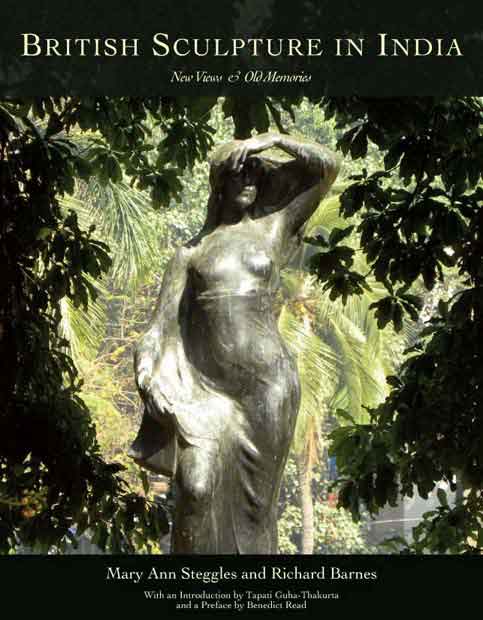Sculpture and Monuments:
British Sculpture in India ~ New Views and Old Memories

British Sculpture in India ~ New Views and Old Memories
Mary Ann Steggles & Richard Barnes
When Mary Ann Steggles began her dissertation on the subject of statues
exported from Britain to colonies in South Asia, the Canadian post-graduate,
now Professor
of Art History, had picked a subject which had fascinated British and Indian
historians for some time.
It concerns a parallel collection in India to the sculptures in the streets
of Britain, dating from 1790-1940 and coming from the same esteemed sculptors.
Over
two hundred marble and bronze figures were shipped, including works by Bacon,
Baily, Banks, Bell, Boehm, Brock, Chantrey, Flaxman, Foley, Frampton, Gilbert,
Jagger, MacKennal, Marochetti, Noble, Pomeroy, Kathleen Scott, Thornycroft,
Weekes, Westmacott and Woolner.
The aim is to present the reader with new and sometimes first views of
the ‘collection’.
This involves some debunking as there are misconceptions, for instance
that the sculptures are disregarded in the host nation. It is an easy
story for
any journalist
with a picture of an old statue covered in cobwebs in some out of the way
godown. Sic transit gloria mundi etc,.
The reality is that the great majority of sculptures by British artists have
survived, largely due to their recognised art qualities, and not because of any
obligation. They are part of Indian history and belong to the Indian government.
Many were originally commissioned and paid for by Indian nationals. Others, a
few, have been removed to places of safety, away from the fury of motor traffic,
and in special cases repatriated. Decisions about some of the statues still have
to be made and this book is likely to be first reference in future discussions
between numerous governing bodies, city planners and state museums in India.
There are post-colonial implications which informed writers will discuss elsewhere,
but here the viewpoint is concerned with art and history seen from a present
day perspective.
British Sculpture in India ~ New Views and Old Memories has four
constituent texts. These are an Introductory Essay
(a view from Calcutta) by the author and
historian, Professor Tapati Guha-Thakurta, placing the general subject
in a modern context in
India. This is preceded by a Preface by Benedict Read, Senior Visiting
Research Fellow at the School of Fine Art at Leeds University, Former Chairman
of
the PMSA and author of Victorian Sculpture, the primary source
of inspiration. There follows a list of the sculptures and about 200 concise
descriptive
essays
written about them. Each entry is structured with the title of the work,
followed by maker’s name, date and location before a pithy outline
in less than 300 words, entwining subject and artist biographies, sculpture
anecdotes, design
details and reports on condition. The descriptions have a clear format
which avoids confusion arising from dozens of Empress Victorias and other
duplications,
since some statues have been moved more than once. They are prepared by
Richard Barnes, who has written about 19th century
sculpture in books and papers. He combines this interest with a general
sense of British
colonial
history
and the
illustrative dynamic of photography. He is a fellow of the
Royal Society of Arts and the Royal Geographical Society and has been for
ten years
an ordinary member of the PMSA. He compares Bombay’s ‘Flora
Fountain’ with
the best and contends the equestrian works in India surpassed those in
the mother country. The scope of this part of the book, which is both inventory
and gazetteer, is widened to include the figurative marble memorials in
the Anglican cathedrals
and churches in Madras, Calcutta and Bombay, adding a number of earlier
works by Georgian sculptors such as Bacon Jr and John Flaxman. In terms
of illustration
this adds tigers, palm trees and mourning madonnas to the volume of public
statues of viceroys and generals.
The most extensive and important part of the book is the writing of
Dr Mary Ann Steggles, Professor of Art History at the University of Manitoba,
the
acknowledged expert in the field with twenty years’ experience of
the subject and a myriad of research visits to India. She offers the full
historical base and account
of the commissioning and exportation of statues from Britain to India.
Her research on British statues in South Asia has been published in many
journals and she authored a small book on the topic
in 2001 and continues to serve as a consultant on the history of the statues
for various
institutions and governmental agencies. Professor Steggles provides a
historical base and account of the commissioning and exportation of sculptures
from
Britain to India, distinguishing statues and discussing their overall dispersal,
commissioning,
and present status.
British Sculpture in India ~ New Views and Old Memories is
designed to be a pleasure to look at with a high concentration of photographic
illustration.
Many are historic
plates from previous centuries and these are balanced with colour photographs
made by Barnes in 2010 and 2011. Placed within and around the text, some
depict a reference, others are all-in-one ‘record’ shots. The
selection, treatment and placing of the photographs are designed to ‘show
off’ the works, and exhibit the skill of the artists.
Authoritative, illustrative and bulging with histories, here is the only book to record and reflect the largest ‘collection’ of British sculptures outside Britain. It is a rare book to be commended to devotees of sculpture in five continents and anyone interested in the endless peculiarities of India’s connection with Britain.
Published with the assistance of the Henry Moore Foundation
British Sculpture in India ~ New Views and Old Memories
ISBN: 978 1872914
41 1
380pp, 200+ colour illus December 2011. £50 h/b
~ Responses, reviews and recommendations
________________________________________________________
Email
contact@frontierpublishing